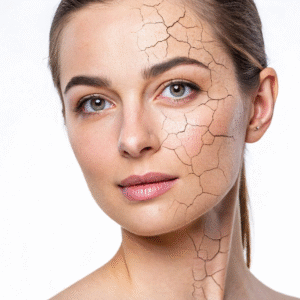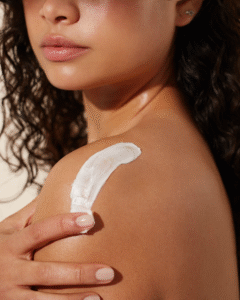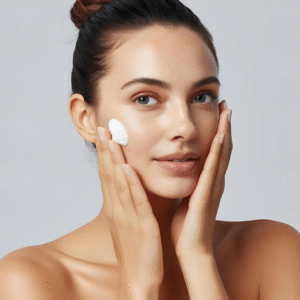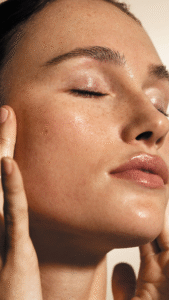Winter Glow Secrets: How to Keep Your Body Soft Even in Cold Weather
1. Understanding Winter Skin Dryness
- Why Skin Feels Tight and Rough in Winter
- Cozy sweaters, hot beverages, and cold breezes are all part of winter, but so is dryness, one of the most prevalent skin issues. The amount of moisture in the air reduces as the temperature drops. Your skin becomes tight, rough, and occasionally itchy as a result of the cold, dry air sucking moisture out of it.
- Winter body care routine the stratum corneum, your skin’s outermost layer, serves as a barrier to keep moisture in. However, because of environmental stress, this barrier weakens over the winter. Additionally, your skin loses its innate capacity to remain elastic and smooth due to the decreased oil production from your sebaceous glands. The texture of your skin changes as a result; it may appear uneven, flaky, or lifeless.

- Heating systems installed indoors exacerbate the situation. They provide an atmosphere that is warm but not very humid, which causes your skin to become dehydrated very fast. Even your bathing routine can have an impact; while long, hot showers are soothing in the cold, they can deplete the skin’s natural oils that protect it. The skin might become tight and rough if moisture is further removed by using harsh soaps or body washes that contain alcohol or sulfates.
- Your nutrition and way of living also have an impact. Dry skin can be exacerbated by dehydration, a lack of good fats, and inadequate water intake. Even the greatest moisturizers may not be helpful if your body isn’t adequately hydrated.
- It’s crucial to make minor but significant adjustments to safeguard your skin. Begin by converting to gentle, creamy body cleansers that include glycerin, aloe vera, or shea butter. Use lukewarm water for showers instead of prolonged exposure to hot water. Use a thick body oil or lotion right after taking a bath to seal in the moisture. Seek out components such as hyaluronic acid, ceramides, or natural oils like coconut, olive, or almond oil.
- Expert Tip: Use your moisturizer on damp skin at all times to help retain moisture and improve hydration for extended periods of time.
- Winter dryness can have an impact on your skin’s health in addition to being a cosmetic concern.
- Redness, irritation, or even fissures that increase your skin’s susceptibility to infections might result from chronic dryness. Therefore, maintaining smooth and healthy skin throughout the winter months requires regular care and hydration.
- The Role of Humidity in Skin Health
- One of the most neglected aspects of skincare is humidity. A balanced humidity level, ideally between 40% and 60%, is good for your skin’s health.
- The air starts to absorb moisture from your skin when the humidity falls below this threshold.
- Transepidermal water loss (TEWL), or the loss of water from the surface of your skin, is accelerated during the winter months when humidity levels frequently drop below 30%, particularly indoors.
- Your skin’s lipid barrier is weakened by this dehydration, making it more difficult to stay hydrated.
- Your body’s skin may feel scaly, tight, and itchy as a result. White spots or tiny cracks may be seen, particularly on the legs, knees, and elbows.
- Hydration from within is also very important. Consuming foods high in omega-3 fatty acids, including avocados, walnuts, and flaxseeds, along with drinking adequate water, fortifies your skin’s moisture barrier from the inside out.
- Expert Tip: Avoid overheating your home because it can exacerbate dryness. Comfort, not too much warmth, is what you want.
- The first step to safeguarding your skin is to understand how low humidity and cold weather damage it. Once the cause is identified, you may take specific action to keep your body hydrated, retain moisture, and keep it feeling soft all winter long.
2. Build Your Winter Body Care Routine
- Your skin’s requirements radically shift in the winter. Your body’s skin barrier has to be protected, repaired, and nourished in addition to being kept warm. Maintaining moisture, avoiding dryness, and regaining suppleness through gentle and regular care must be the main goals of a winter body care regimen. Let’s dissect it in detail.

- Gentle Cleansing is Key
- Cleaning is the first stage in every body care regimen, but in the winter, the method of cleansing is just as important as the products used. Because many soaps and foamy gels contain alcohols and sulfates that deplete natural oils, most individuals make the error of using the same body wash year-round. This may not be as obvious in the summer, but it causes flaky, tight skin in the winter.
- Use a cream-based body wash or moisturizing cleanser instead. Seek out components with calming and moisture-locking qualities, such as glycerin, aloe vera, shea butter, oats, or coconut milk. These aid in skin cleansing without stripping your skin of its natural oils.
- When taking a bath, use lukewarm water rather than boiling. Although hot water feels soothing in the cold, it quickly dehydrates the skin and damages the barrier that protects it. The best way to keep skin healthy is to take a quick, warm shower and then moisturize.
- 💡 Professional Advice: After taking a bath, gently pat your skin with a towel rather of rubbing it. Your moisturizer works better if you leave some moisture on your skin.
- Exfoliate Wisely
- Even in the winter, exfoliation is crucial, but it needs to be done sparingly and gently. Your skin feels rough and uneven when dead skin cells accumulate because they prevent moisturizers from being absorbed. On the other hand, excessive exfoliation can aggravate dryness and create irritation.
- Choose gentle, natural scrubs prepared with sugar, coffee, or oats mixed with oils or honey. Depending on your skin type, exfoliate once or twice a week. Pay attention to arid regions such as the ankles, elbows, and knees.
- Choose mild chemical exfoliants with lactic acid or fruit enzymes instead of physical scrubbing if your skin is very dry or sensitive. These exfoliants remove dead cells without creating tiny rips in the skin.
- Layering Your Body Care Products
- Similar to your skincare regimen for your face, layering items is beneficial for your body as well. Apply a serum or oil first, followed by a body butter or thick lotion to lock everything in. Rosewater is a great choice for a gentle moisturizing mist or toner. By using this stacking process, moisture is trapped and kept from evaporating.
- Use a body lotion or serum that contains ceramides or hyaluronic acid for further hydration. These components strengthen the moisture barrier of your skin and increase its resistance to dryness and cold temperatures.
- Consistency is the Secret
- Consistency, not a single product, is the true key to soft winter skin. Even a single day without moisturizing can result in obvious dryness. Maintain a simple yet consistent routine by cleansing, moisturizing, and protecting every day.
- A weekly oil massage is one example of a little extra care that keeps your skin looking radiant and helps with circulation. Your body will naturally begin to retain more moisture over time, and dryness will drastically decrease.
3. Deep Moisturization Tips
- Moisturization is your best defense against dryness, flakiness, and harsh texture when it comes to winter body care. Because of the low humidity, chilly winds, and interior heating during the winter months, your skin loses water quickly. Applying lotion is only one aspect of deep moisturization; knowing what, when, and how to use it will help you maintain healthy, radiant skin throughout the year.

- Use Rich Body Butters and Oils
- Because they don’t hydrate well enough, light lotions that are effective in the summer frequently don’t work in the winter. Richer, thicker compositions that establish a barrier to keep moisture in your skin are what it needs. Try to find items that contain avocado, mango, cocoa, or shea butter. These organic emollients increase suppleness, heal fissures, and smooth tough skin.
- Another great choice for intensive hydration is oils. The oils of coconut, almond, jojoba, olive, and argan provide deep nourishment and restore lost lipids, which are vital for maintaining the suppleness and suppleness of your skin. Additionally, oils absorb easier on warm skin, which makes them perfect for a soothing evening massage or after a shower.
- Expert Tip: Before using your oil, warm it up a little.To increase blood circulation and guarantee improved absorption, gently massage in circular patterns.
- Apply Moisturizer on Damp Skin
- The timing of your moisturizer application is one of the most neglected skincare procedures. Applying body lotion or oil just after taking a shower, while your skin is still slightly damp, is crucial. This helps retain the moisture that is already there for a longer period of time.
- Within two to three minutes, apply your moisturizer after gently patting your skin with a towel—do not rub. The softness and hydration of your skin throughout the day can be greatly improved by doing this easy step.
- Consider layering your moisturizer if your skin is very dry. Apply a moisturizing body lotion first, then a thin coating of body oil or butter. This double-layer method provides your skin a radiant, healthy glow and forms a long-lasting moisture barrier.
- Choose the Right Ingredients
- Ingredients that hydrate and retain moisture should be the main emphasis of winter skincare products. Seek out body care items that have:
- Water is drawn to and held in skin cells by hyaluronic acid.
- Ceramides: Prevent moisture loss and restore the skin’s protective layer.
- Panthenol and glycerin: Bring moisture to the skin and relieve dryness.
- As an antioxidant, vitamin E guards against weather-related harm.
- Natural Oils: Olive, almond, and argan oils offer profound sustenance.
- Steer clear of products that include parabens, alcohol, or artificial fragrances since these might aggravate dryness or create irritation.
- Nighttime Moisture Boost
- Bedtime is the ideal time for intensive moisturizing because your skin heals itself at night. Before bed, slather on a generous amount of body lotion or oil, focusing on dry spots like palms, knees, elbows, and heels.
- After applying cream, put on cotton socks and gloves for more protection; this will seal in moisture overnight and leave your skin feeling immaculate in the morning.
- Pro Tip: To keep the air moist while you sleep in a heated area, use a humidifier. Your skin won’t dry out over night thanks to it.
- Consistency Brings Results
- Deep moisturization is a daily routine rather than a one-time event. Maintaining consistency keeps your skin supple, moisturized, and cold-resistant. Regular nourishment causes your skin to begin generating and holding onto moisture on its own, eliminating the need for frequent reapplication.
- You’ll notice improved elasticity, a healthier winter glow that lasts all season, and smoother texture after just a few weeks of consistent treatment.
4. Hydrate from Within
- Most people think of external moisturizers like lotions, oils, and creams when they think about winter skincare. However, genuine skin health starts on the inside. The largest organ in your body, your skin’s look is a reflection of your internal nutrition and moisture levels. If your body is dry from the inside out, no amount of body butter can adequately moisturize your skin.
- Because they don’t feel as thirsty in the cold, people typically drink less water. It’s easy to forget that your skin still loses moisture through breathing and evaporation when the temperature is cold and warm indoors. One of the primary causes of drab, dry, and itchy skin in the winter is this covert dehydration.
- Drink Enough Water – Even When You Don’t Feel Thirsty
- Your body requires hydration on a daily basis, regardless of the season. Your skin loses water more quickly in the winter because of the often dry interior and outdoor air. Skin tightness or roughness, as well as a fatigued appearance, can result from even slight dehydration.
- Try to consume eight to ten glasses of water each day. You may naturally add taste to plain water if it seems monotonous:
- Add slices of cucumber, mint, or lemon to it.
- Sip warm herbal drinks such as green tea, tulsi, or chamomile.
- Have broths or soups that are both nourishing and hydrating.
- Expert Tip: To remind yourself to drink water throughout the day, keep a small bottle next to your bedside or place of work. Hydration should be regular, not sporadic.
- Eat Skin-Friendly, Hydrating Foods
- The way your skin feels and appears in the winter is greatly influenced by your diet. Eat more meals high in antioxidants, vitamins, and healthy fats because these help to increase moisture retention and fortify your skin’s barrier.
- Among the best options are:
- Flaxseeds, chia seeds, walnuts, and salmon are among the foods high in omega-3 that help lower dryness and inflammation.
- Almonds, sunflower seeds, oranges, strawberries, and other foods high in vitamin E and C help shield your skin from oxidative damage and increase its suppleness.
- Monounsaturated fats from avocados and olive oil help to maintain the softness and suppleness of your skin.
- Hydration is naturally added by coconut water and fresh fruits like apples, oranges, and melons.
- Steer clear of processed meals, alcohol, and caffeine in excess as they dehydrate your body and impair your skin’s protective layer.
- Include Collagen and Antioxidants
- The protein that provides your skin its suppleness and firmness is called collagen. Collagen degrades more quickly as we age or get dry. Consume foods high in vitamin C, such as citrus fruits, bell peppers, and amla, as well as nutrients that promote collagen, such protein and zinc, to help your body produce collagen naturally.
- Antioxidant-rich foods, such leafy greens, berries, and green tea, also help shield skin cells from environmental stress and cold-induced free radical damage.
- Pro Tip: Try a smoothie in the morning that has spinach, banana, almond milk, and chia seeds. It hydrates, nourishes, and contains nutrients that are good for your skin.
- Balance Internal and External Care
- Topical care is still necessary if you want to hydrate your skin from the inside out. Combining external moisturization with internal hydration yields the best outcomes. Your body can better absorb and hold onto moisture when you eat a healthy diet and drink plenty of water. This provides your skin a long-lasting radiance and increases the effectiveness of your moisturizers.
- Consider it a team effort: your body is protected from the elements by the things you put on it, and it is nourished from the inside out by the things you eat.
5. Protect Your Skin from Harsh Weather
- The low humidity, chilly air, and frequent temperature changes of winter may be quite harsh on your skin. Regardless of how much balm you apply, you may experience scratchy hands, flaky legs, or chapped lips. This is because winter weakens your skin barrier, which is the layer that keeps moisture in and shields you from external stress.
- You must shield your skin from the inclement weather both indoors and out if you want to keep it soft and radiant throughout the year. Let’s investigate the most effective approaches to that.

- Cover Up Before Stepping Out
- Properly protecting your skin is one of the easiest yet most efficient methods to keep it safe throughout the winter. Your skin becomes dry and sensitive as a result of the chilly wind depleting it of moisture. Wear full-sleeved clothing, gloves, and scarves whenever you go outside to protect exposed skin parts including your hands, neck, and arms.
- To prevent irritation, choose materials that are breathable and soft, such as fleece or cotton. If you enjoy wearing wool sweaters, wear a soft cotton shirt underneath to protect your skin from the itching and redness that wool can occasionally produce.
- Professional Advice: Before dressing, dab on some body oil or moisturizer. It creates a barrier that reduces clothing friction and keeps things from drying out.
- Use SPF in Winter Too
- It’s a common misconception that sunscreen is only required in the summer. UV radiation can harm your skin even in cold or overcast conditions, causing uneven tone, dullness, and early aging. Up to 80% of UV radiation can be reflected by snow, thus your skin may be exposed twice: once from above and once from below!
- If you’re wearing open shoes, apply a broad-spectrum sunscreen with an SPF of 30 or greater to all exposed areas, including your face, neck, hands, and feet. Choose moisturizing sunscreens that combine protection and hydration, such as those with hyaluronic acid, vitamin E, or aloe vera.
- If you spend a lot of time outside, reapply every three to four hours, and remember to moisturize your lips.
- Shield Skin from Indoor Heat
- Although staying warm near heaters or blowers is wonderful, artificial heat dries the air, lowering humidity and removing the natural moisture from your skin. This causes your skin to become tight, flaky, and irritated over time.
- Maintain a balanced indoor atmosphere to address this. Maintain a comfortable temperature and add moisture to the air by using a humidifier. As an alternative, you can naturally increase humidity by setting bowls of water close to heat sources.
- Drink lots of water throughout the day – interior heat dehydrates you from within, even if you don’t feel thirsty.
- Pro Tip: To combat overnight dryness brought on by heaters, apply a heavier moisturizer or body butter before bed.
- Protect Your Skin Barrier
- The first line of defense is the skin barrier. Your skin is more vulnerable to redness, irritation, and moisture loss when it is impaired. Use body care products high in ceramides, squalane, shea butter, and niacinamide to fortify it. These components aid in lipid restoration, hydration retention, and the development of tolerance to adverse environments.
- Avoid using alcohol-based toners or excessive exfoliation as these might further weaken the barrier. Instead, concentrate on using nutritious, mild products that help to calm and soothe the skin.
- Mind Your Shower Routine
- Although it may seem easy, how you bathe has a big influence on the health of your skin in the winter. Although they may seem soothing, long, steamy showers can deplete your skin of vital oils. Choose to take ten to fifteen-minute lukewarm showers. Make use of a body wash that cleans without drying out and is creamy and non-foaming.
- Apply a moisturizer or oil very away after taking a bath to keep your skin hydrated and protected all day.
6. Pamper Your Skin Weekly
- Winter skincare involves more than just hydrating your skin every day; it also involves treating it once a week to deeply nourish and heal it. Your body may feel drab and scratchy from the chilly weather, interior heating, and continuous clothing exposure. Weekly routines can help restore your shine and keep your skin healthy throughout the year. Gentle exfoliation, nourishing masks, and oil massages are some examples.
- Every week, let’s discuss how to give your skin the attention it so well deserves.

- DIY Body Masks and Scrubs for Deep Nourishment
- Dead cells are removed, texture is improved, and moisturizers are better absorbed with weekly exfoliation and masks. Winter exfoliation needs to be mild, though, as the objective is to shine rather than peel.
- You may try these natural DIY body washes and masks at home:
- Oatmeal-Honey Body Scrub:
- Add 1 tablespoon honey, 1 tablespoon milk, and 2 tablespoons oatmeal powder.
- After five minutes of light massaging wet skin, rinse.
- Honey provides deep hydration, while oatmeal relieves inflammation.
- Scrub with Coffee and Coconut Oil:
- Mix 1 tablespoon coconut oil with 2 tablespoons coffee powder.
- To increase circulation and get rid of dead skin, scrub in circular motions.
- Excellent for rough, drab areas like knees and elbows.
- Turmeric & Yogurt Body Mask:
- Mix together 1 tsp gram flour, 2 tablespoons yogurt, and a pinch of turmeric.
- Put on as a mask, let it sit for ten minutes, then rinse it off.
- Brightens skin tone and restores natural softness.
- Professional Advice: Only exfoliate once or twice a week. Excessive use might cause dryness and deplete essential oils. Always apply a heavy body oil or moisturizer afterward.
- Warm Oil Massage Rituals
- One of the earliest and best wintertime routines is a heated oil massage. This Ayurvedic practice, called Abhyanga, not only nourishes your skin but also relaxes your body, increases circulation, and fortifies your immune system.
- Select nutritious oils such as:
- Coconut oil is antimicrobial and incredibly hydrating.
- Sesame oil increases skin suppleness and provides warmth.
- Rich in vitamin E, almond oil aids in the fading of rough areas.
- Starting from your feet and working your way up toward your heart, massage the oil in circular motions after slightly warming it. This enhances blood flow and lymphatic drainage. Before taking a shower, let it sit for at least twenty minutes.
- Expert Tip: Add a few drops of argan or rosehip oil to your foundation oil for an added radiance.
- Hydrating Baths and Steam Therapy
- Your skin and mind can benefit greatly from a weekly moisturizing bath. To warm bathwater, add a few drops of essential oils, such as chamomile or lavender, or a few tablespoons of milk or honey. These components soothe your senses and soften your skin.
- As an alternative, try steam therapy once a week; the warm, steamy atmosphere helps your skincare products absorb better and opens pores. Just remember to moisturize right away to ensure that the hydration is retained.
- Repair Overnight with a Rich Mask or Cream
- Allow your skin to heal overnight after a demanding week. Before going to bed, slather on a thick layer of body lotion, shea butter, or oil blend. Pay attention to dry regions such as knees, heels, and elbows for additional nourishment.
- After applying the cream, putting on soft cotton socks or pajamas helps retain the moisture and stops product transfer. Your skin will feel refreshed and smoother when you wake up.
7. Bonus: Nighttime Care Routine
- The most crucial aspect of winter body care is your nightly regimen. Your skin enters healing mode as you sleep, repairing damage from the harsh daylight environment, restoring suppleness, and generating new cells. Because of this, the things you do before bed have a significant impact on how your skin feels and appears in the morning.
- Even on the coldest nights, a good nightly regimen helps you wake up with smooth, moisturized, and radiant skin by nourishing your entire body. Let’s get started on creating the ideal winter evening routine.

- Overnight Moisture Lock
- The best time to properly moisturize your skin is right before bed. As you sleep, your body temperature steadily rises, promoting better product absorption and skin regeneration. Your skin can nurture and heal itself without interruption if you use a body oil or thick moisturizer at night.
- Choose rich, thick, emollient-based products like shea butter, cocoa butter, or almond oil. These create a barrier that protects the skin and prevents water loss over night. Pay particular attention to the dry parts of your body, such as your hands, knees, heels, and elbows.
- Expert Tip: Before using your moisturizer, mist your body with a moisturizing spray or a small amount of rosewater. This adds moisture for your cream to seal in, making your skin even smoother in the morning.
- Humidifier Magic for Nighttime Hydration
- Sleeping with the right amount of humidity in the air is one of the most underappreciated secrets to radiant skin. Because winter air is typically dry, especially in heated spaces, your skin loses moisture throughout the night.
- A humidifier can significantly improve the air quality in your bedroom. It keeps your skin, lips, and neck from drying out, avoids dehydration, and replenishes the moisture in the air. If you don’t have a humidifier, you can do the same thing by setting a bowl of water beside your bed or next to your heater.
- Pro Tip: To promote relaxation and better sleep, add a few drops of essential oils, such as eucalyptus or lavender, to your humidifier.
- Protect Hands, Feet, and Lips Overnight
- Since the hands, feet, and lips are the driest and most exposed parts of the body in the winter, they require special care at night. Apply a thick foot balm or hand cream with petroleum jelly, shea butter, or urea before bed. Then, to retain the moisture, put on cotton socks and gloves.
- By morning, your skin will be deeply hydrated and smooth thanks to this easy method. Apply a natural lip balm with vitamin E, cocoa butter, or beeswax to your lips. Lip licking exacerbates dryness, therefore refrain from doing it.
- Calm Your Body and Mind
- Your nightly ritual is about relaxation, not simply taking care of yourself. A quick self-care routine or a warm oil massage before bed will help you relax and get a better night’s sleep. Aim for at least 7 to 8 hours of good sleep every day because stress and sleep deprivation can make your skin seem lifeless.
- Give yourself a few minutes to relax, light a candle, and use soothing essential oils like lavender or chamomile. A bright dawn after a restful night.
